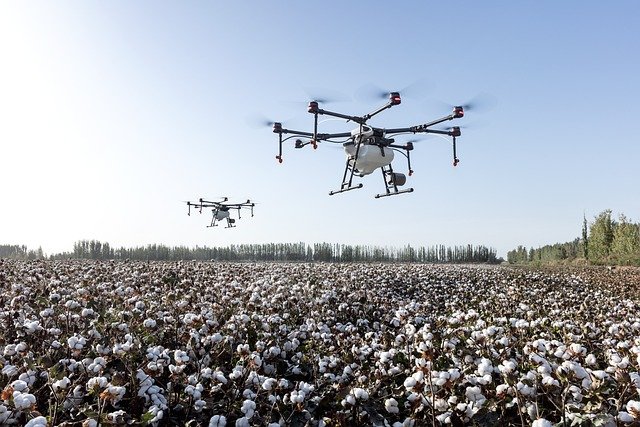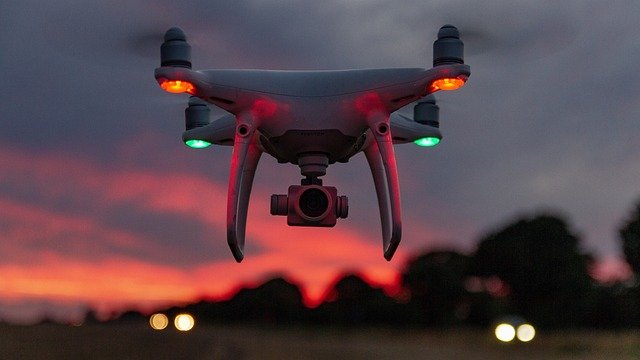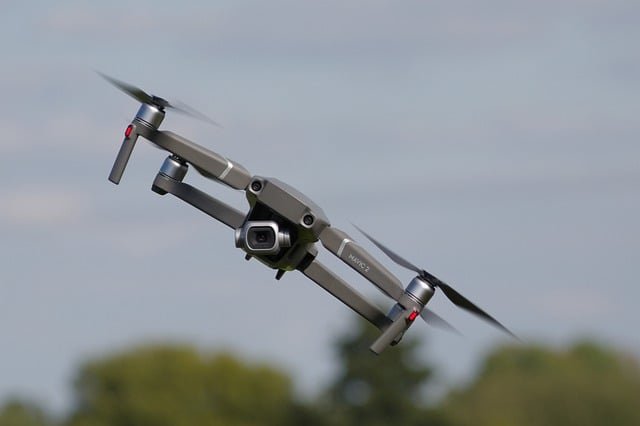SEC | S20W6: "The Use of Drones in Agriculture"
Hello everyone!
Today I am here to join and explore a wonderful contest about The Use of Drones in Agriculture by @xkool24. If you want to join it then:

What role have drones (unmanned aerial vehicles) played in modernizing agriculture? Use your country as an example if applicable. My country is Pakistan
Drones have transformed agriculture to a modern agriculture. It has put a lot of innovation in agriculture that has increased the productivity of the farms.
In Pakistan agriculture is the biggest part of the economy. And in Pakistan for new are being used to overcome challenges such as inefficient farming practices. Their implementation helps to overcome water scarcity and crop monitoring issues. Here are some roles that drones play to modernize agriculture in Pakistan.
Precision Agriculture
As there are drones which are equipped with the sensors and cameras. So we can use them to monitor the health of the crops. We can capture detailed images of the fields. These images provide data of the health of the plants. We can check the moisture level and efficiency of the nutrients. They allow the farmers to make good decisions based on the data of the pictures. In Pakistan it is very useful especially for the large scale farms where manual inspection is not possible.
Efficient Irrigation Management
Agriculture irrigation is one of the major problems in Pakistan. And it counts especially in provinces like Balochistan and Sindh. We can asses the moisture of the soil with the help of the drones. We can get these details from thermal imaging. It enables the farmers to enhance the irrigation system. They can conserve water. Efficient irrigation system leads to successful crop yield.
Fertilizer and Pesticide Application
We can use drones to spray fertilizers and pesticides on the crops. They help us to reduce the amount of chemicals used. And they also help us to reduce the waste. In Pakistan traditional spray methods are used and they are not much effective. I am sure if we use drones for the spray we can control the spray of pesticides and fertilizers in required areas without wasting these pesticides and fertilizers. It improves the health and reduces the environmental damage and costs.
Crop Surveillance and Early Detection of Issues
Drones provide real time surveillance and coverage of the large areas. They allow the farmers to detect pest infestations, diseases and weed growth. They help us to detect these problems in the early stages. In Pakistan the usage of drones will help the farmers to prevent the crop losses by detecting these issues at first stages. And it will increase the overall efficiency of the fields.
Land Mapping and Surveying
It is important to map the land for the understanding of topography. It helps to check the soil conditions and field boundaries. In regions such KPK drones can be used for the detailed maps creation. It helps in precision farming. It allows the farmers to manage their fields in a better way by planting the crops in suitable areas.
Monitoring Livestock
All the areas where livestock is heavy drones can be used to monitor the herds over a vast area. It is very useful to monitor the animals where we cannot monitor the animals manually such as in the mountains. Drones help to check the livestock health and safety. They help us to track their movement and in this way they reduce the risk of loosing them.
Disaster Management
Drones help us to asses the impact of the natural disasters such as floods or locust swarms. In Pakistan these natural disasters have affected some areas greatly especially Sindh and Balochistan. Drones help to survey the damaged area quicky. nd it helps the government as well as the farmers to plan better recovery efforts in an efficient way.How do drones contribute to precision and efficiency in agricultural practices? What are the key benefits of using drones in agriculture?
Drones have significant contribution in the precision and efficiency in the agriculture. They provide real time data and enables the farmers to make informed decisions. They help to enhance productivity and sustainability. Here is how friend contribute in precision and efficiency:
Contribution to Precision and Efficiency

Real-time Crop Monitoring and Data Collection
As nowadays drones are available which have thermal sensors. They can capture the detailed pictures of the food and the soil. They can be used to check the water level. Farmers monitor the health of the plants with drones. Farmers can easily detect the deficiency of the nutrients. As in the traditional inspection we cannot cover a large area but with the help of the drones we can cover a large area in minimum time. So the use of drones help us to save the time.
Targeted Application of Fertilizers and Pesticides
Drones help us in the target application of the fertilizers and pesticides. We can apply herbicides on the target places. This targeted approach decreases the chemical use. It also ensures that crops can get necessary treatment without over dose. It helps to reduce the costs and environmental impact.
Efficient Land and Soil Mapping
Drones help us to capture the detailed maps of the land. It helps us to make good planes for the plantation, irrigation as well as for the soil management. It helps in precision farming. And we can manage different areas according to their conditions. We can map the soil composition, topography and moisture level.
Enhanced Irrigation Management
As drones can provide a larger picture of the food so it can help us the irrigation system. We can check the moisture level. According to the moisture level we can schedule irrigation. It helps to avoid over watering. And in this way we can use water more efficiently. And it is really very helpful for those areas which have scarcity of water.
Early Detection of Problems
Drones help us to identify the problems in the plants effectively and quickly. We can identify pest, fungal infections as well as nutrients deficiency. And we can cure these problems at time to avoid damage to the crops. And it helps to reduce crop loss and it improves the overall yield.
Key Benefits of Using Drones in Agriculture
Here are the key benefits of using drones in agriculture:
Increased Productivity and Yield
Drones helps us to get the details of the fields by detecting the problems in the plants. And after the detection we can cure the infected plants which ultimately increase the yield of the plants.
Cost Efficiency
Drones help us to reduce the labor costs. Be used we can automate many tasks such as field monitoring and spraying. Drones also atmuyonate the data collection. Moreover they help us to input the pesticides and fungicides in the right places where they are required and in this way the cost of pesticides is also reduced.

Time Savings
Traditional inspection of the fields is very tine taking. But with the help of the drones we can inspect the fields efficiently in very less time. And in this way it saves time and enable to perform many tasks. The quick inspection of the plants also helps the farmer to take the decisions with time.
Sustainability and Environmental Protection
As the drones reduce the overuse of the chemicals so they promote sustainable agricultural practices. We can save fertilizers as well as water. Spray on the targeted places also reduce the environmental pollution and soil degradation.
Disaster Management and Recovery
Drones also help us to asses the natural disasters affected areas from the vast area of the agricultural land. After this rapid assesment we can follow the recovery plans. It minimises the impact of the thr natural disasters. And in this way the productivity and yield increases.
Better Resource Management
Drones help in optimizing the use of resources. These resources include water, land and chemicals. We can use all the resources precisely where they are needed. This helps to reduce the waste and it increases the overall sustainability of the farming.
How do drones help manage soil moisture and nutrient levels in crops?
Drones play an important role to manage soil moisture. They help to manage the nutrients level with the integration of the advance technology. Here is the detail that how they help to achieve this.
Managing Soil Moisture and Nutrient Levels Using Drones
Drones have specific sensors and these sensors help us to monitor the moisture and nutrients level of the fields. This is done in the following ways:
Soil Moisture Analysis: Drones which have thermal and infrared sensors detect temperature of the soil and moisture of soil. Thermal cameras identify the areas which are dry or wet. They help the farmers to adjust the irrigation schedules. We can maintain the schedule according to the current conditions of the fields. It avoids over watering and under watering. It leads to the normal use of the water.
Nutrient Assessment: Drones which have multispectral and hyperspectral sensors are used to capture the data from the crops. It captures data on different levels of wavelengths. We can assess the health of the plants their pattern of growth and deficiency of the nutrients. For example: These drones help to detect the low levels of chlorophyll in the leaves. It can detect the deficiency of nitrogen. And we can give fertilizers to the deficient areas.
So in this way drones help the farmers to implement irrigation and fertilization strategies. They help to reduce costs and promote sustainable agricultural practices.
Explain the significance of multispectral and hyperspectral imaging sensors in agricultural drones.
Significance of Multispectral and Hyperspectral Imaging Sensors in Agricultural Drones
As I have mentioned it in the above section but here is the detail of these imaging sensors in the agriculture drones.
Multispectral and hyperspectral imaging sensors are important tools in the agriculture drones. They are used to capture the detailed spectrum. These are the details to describe their significance:
Multispectral Sensors
Multispectral sensors capture images. They capture in a few discrete bands. This band usually includes visible and infrared wavelengths. In the visible it includes red, green and blue.- They are used to evaluate plant health. They do it by using vegetation indices like the Normalized Difference Vegetation Index. It represents chlorophyll content in the leaves.
- They identify crop stress, pest infestations and nutrient deficiencies.
- They are used to monitor canopy cover and leaf area index. It helps the farmers to gauge overall crop growth and productivity of the farms.
Hyperspectral Sensors
These sensors are very keen. They capture data in hundreds of narrow bands in the electromagnetic spectrum. They provide more granular information as compared to multispectral sensors.
- They can detect changes in plant physiology. It indicates specific nutrient deficiencies. It also highlights the presence of diseases.
- They differentiate between types of plant species and soil types. They detect the presence of weeds.
- They can provide detailed information about the water stress. And it is very helpful for the precise nutrients management.
The high resolution data from these sensors enable the farmers to accurately assess plant health. They optimize the use of water, fertilizers and pesticides.
How drones help in soil mapping and why is it important for precision farming?
Drones play a critical role in soil mapping. Drones help us to collect high resolution images. We can get geospatial data. This data provides information about soil characteristics such as texture, structure, moisture levels and nutrient content. This is achieved through the following methods:
Generating Detailed Topographical Maps: Drones capture 3D maps of the topography of the fields. It highlights the elevation changes. We can detect the slope and terrain variations with the help of the drones. We can understand the water flow patterns. We can detect erosion prone areas which help us in the irrigation and plantation strategies.
Assessing Soil Variability: Drones allow us to use imaging sensors. Drones detect variations in the properties of the soil. Farmers can identify the zones which have different soil fertility and moisture level. So the farmers can do some management. They can treat each done in a different way. And in this way farmers can fulfil the needs of each done in an efficient way by implementing strategies for the fertilizers, seeds and irrigation.
Creating Variable Rate Application (VRA) Maps: The information from soil mapping is used to develop VRA maps. It helps the farmers to develop and define quantities of seeds, fertilizers and water. And it reduces input waste. And it ensured uniform growth of the crops and it improves overall productivity of the farm.
How drones help in soil mapping and why is it important for precision farming?
Importance of Soil Mapping for Precision Farming

Optimized Resource Allocation
Soil mapping helps the farmers to allocate the resources efficiently. Farmers can manage water, fertilizers and pesticides in an effective way. Because farmers can point out where they are most in need. This reduces waste and lowers the costs.
Enhanced Crop Yields
High crop yields are only possible when we understand the specific needs of each part of the field. Farmers can make it sure by the soil mapping that which part is in great need. They can determine if the crops are getting the right amount of nutrients and water. It leads to good health of the plants with improved yield and production.
Reduced Environmental Impact
We can manage the overuse if chemicals and water with the help of soul precision. It can reduce leaching and soil degradation. It promotes more sustainable farming practices.
Improved Soil Health
Accurate soil data allows farmers to address soil issues like compaction, salinity, or erosion early on, helping maintain or even improve soil health over time.
Conclusion
Drones are really very helpful in the agriculture and they innovate the traditional agricultural practices. They help to monitor the folds in less time and in efficient way. They help to detect the problems in the fields such as pests. We can help drones for spraying on the fields. Moreover we can target the specific areas for the pesticides and fertilizers with the help of drones. Nowadays drones have high quality sensors which help to detect the soil moisture and nutrients levels. So the drones help in the optimization of the crop production. They reduce the labor cost. They reduce the environmental impact and they also enhance the overall sustainability of agricultural practices.
I invite @suboohi, @patjewell and @fombae to join this contest.
X Promotion: https://x.com/stylishtiger3/status/1847242037059338530
Thank you so much @max-pro
Welcome to the agro-learning challenge season 20.
Observations and suggestions:
. Nice explanation about drone's role in modernizing agriculture. Drones has brought about much developmental advacement which cut across some of our vital farm practices
. We can also attribute some of these indices as drones' efficency; enhanced decision-making.amd reduced use chemical through precision in farm. Nice explanation on the benefits.
. In handling both moisture and nutrient levels, some of the drone features have helped in this.l path. The thermal, multispectral, amd hyperspectral imaging sensors are of a great essence.
. Thank you for your shared views shared. We hope to see more of your entries next time.
Hola apreciado amigo. Que bueno que en tu país hayan sabido aprovechar esos avances. Es impresionante como un robot tenga capacidad para desarrollar la agricultura en aspectos tan importante. Te deseo éxitos y bendiciones.